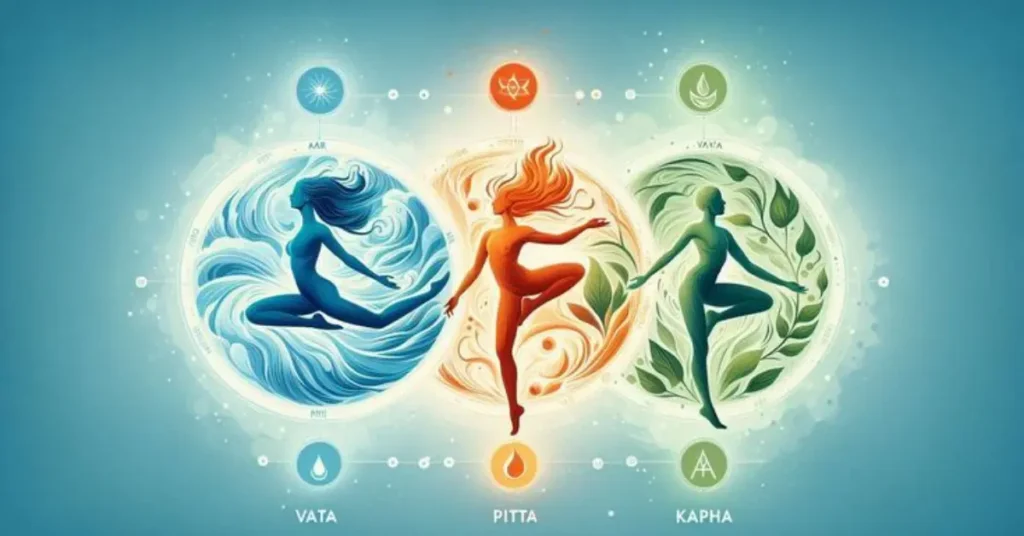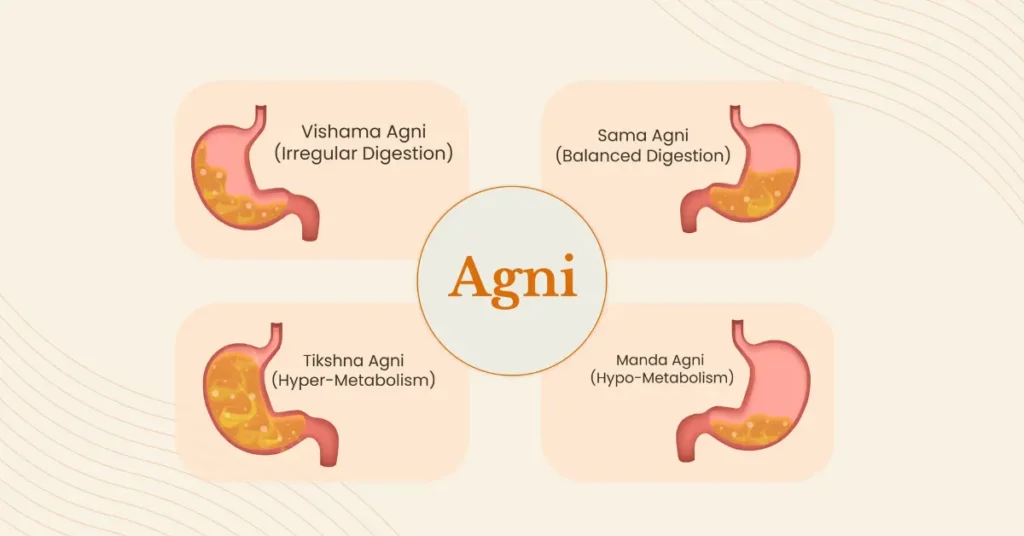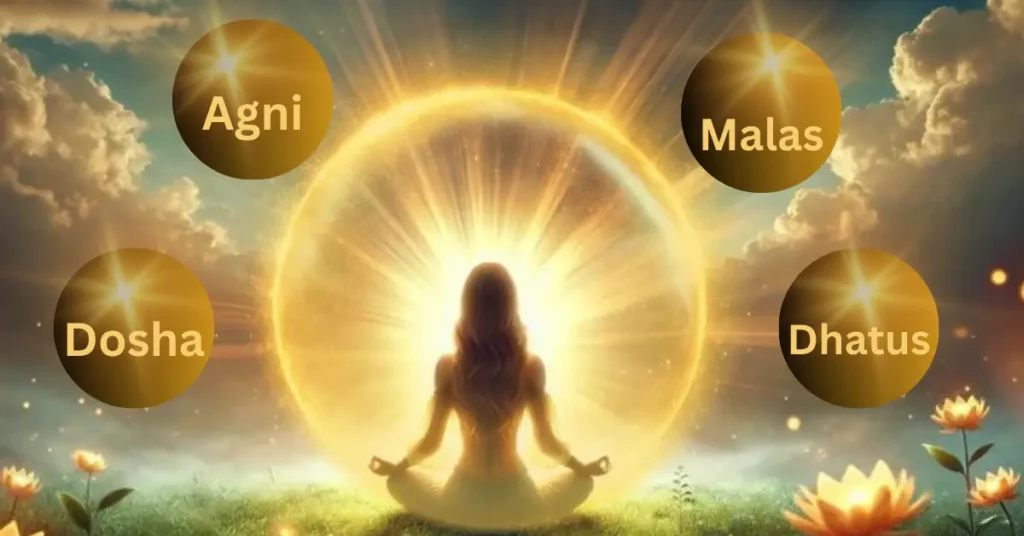Let’s be honest—most of us have tried every shortcut for “wellness” under the sun. Keto today, detox juice tomorrow, a 5-minute meditation app we downloaded but never opened. Sound familiar?
But here’s a question nobody’s asking: What if the real solution isn’t new at all?
What if it’s been quietly waiting for us for, say… 5,000 years?
Enter Ayurveda—India’s ancient science of life and longevity. No hype. No hashtags. Just time-tested principles that treat you like an actual human being, not a machine.
Ayurveda doesn’t throw random superfoods at your face. It starts with something deeper: understanding how your body, mind, and nature are all connected. And at the heart of it all? Just four simple basics. That’s it. Four pillars that quietly hold up your health—even when life feels like a circus. Curious? Here’s What Are the 4 Basics of Ayurveda.
1st Basic of Ayurveda: Doshas
Let’s clear one thing up: Ayurveda doesn’t believe in one-size-fits-all health advice. You’re not a robot. You’re a unique blend of energies, moods, cravings, and random back pain at 3 PM. Ayurveda sees that—and it breaks it down into what it calls the Doshas.
So… what the heck is a Dosha?
In simple terms:
Doshas are your body’s bio-energy types, made from combinations of the five elements (earth, water, fire, air, and space).
They explain everything—from why your friend thrives on salads while you bloat like a balloon, to why some people meditate at 5 AM and you hit snooze nine times.
There are three main Doshas, and most of us are a combo (but usually one is dominant).

Vata Dosha – The Windy One
This one’s all about movement. If your body were an app, Vata would be the fast-forward button.
- You think fast. Talk fast. Forget fast.
- You’ve probably skipped meals not because of discipline—but because you straight-up forgot.
- Cold hands? Dry skin? 17 browser tabs open in your brain? Classic Vata.
- When balanced: You’re creative, lively, and full of bright ideas.
What helps? Warm food, slower routines, grounding activities—basically, the opposite of the chaos you secretly love.
Pitta Dosha – The Fiery One (Fire + Water)
Pitta is your inner fire. It rules digestion, focus, and passion. But let’s be real—it also causes hangry outbursts, spicy opinions, and spontaneous rage at slow walkers.
- You love lists, logic, and being right.
- You get stuff done—but also snap when hungry (watch out, world).
- Your skin may be sensitive, and so is your temper.
- When balanced: Sharp mind, strong metabolism, natural leader vibes.
- When out of whack: Heartburn, skin rashes, irritability, and that “I NEED AC” feeling.
What helps? Cooling foods, time outdoors (shade, not sun), and not treating life like a never-ending competition.
Kapha Dosha – The Chill One (Earth + Water)
Kapha is stable, slow, and sweet. Think of it as your body’s built-in hug.
- You’re the calm friend, the good listener, the nap enthusiast.
- You love food, warmth, and cozy environments.
- But when out of balance? You get sluggish, gain weight easily, and might Netflix too hard.
- When balanced: Loyal, caring, emotionally steady.
- When imbalanced: Low motivation, emotional eating, stuck energy.
What helps? Movement, light meals, stimulation, and saying “yes” to change (even if you’d rather stay in bed).
| Dosha | Core Energy | You When Balanced | You When Off | You Need More Of |
|---|---|---|---|---|
| Vata | Air + Space | Creative, Quick, Fun | Anxious, Cold, Forgetful | Warm food, Routine |
| Pitta | Fire + Water | Focused, Driven, Sharp | Irritable, Overheated, Judgy | Cooling food, Relaxation |
| Kapha | Earth + Water | Calm, Loving, Loyal | Lazy, Heavy, Emotional | Movement, Light meals |
Okay, quick question:
You eat healthy, but still feel bloated, tired, or foggy. What gives?
Answer: Your Agni might be sleeping on the job. So… What Is Agni?
2nd Basic of Ayurveda: Agni
In Ayurveda, Agni means “fire.” But it’s not just about food digestion—it’s your metabolism, gut strength, clarity, and ability to transform anything you consume: food, emotions, even thoughts.
Basically, Agni is that inner flame that:
- Digests your meals
- Absorbs nutrients
- Burns toxins
- Powers your energy
- Keeps your body and brain sharp
If Agni’s working well, you’re on fire in the best way. If not? You’re either sluggish, bloated, gassy, acidic, or emotionally stuffed.
“You are not what you eat. You are what you digest.”
— Ayurveda, casually calling out your kale smoothie obsession

When Agni is Strong:
- You feel light, focused, and energetic
- Hunger is real (but not desperate)
- Skin glows, thoughts flow, and… well, you poop like a champion (yes, we said it)
When Agni is Weak or Off:
- You feel heavy, bloated, or nauseous.
- Food “just sits there”.
- Brain fog, low energy, weird cravings.
- Toxins (called Ama) build up—hello, acne, bad breath, and unexplained fatigue.
How to Keep Agni Happy (Without Burning It Out)
You don’t need to live on ginger tea and hope. Just follow a few smart tweaks:
Eat warm, cooked meals – your stomach isn’t a microwave.
Avoid overeating – being full ≠ being nourished.
Spice it up – cumin, ginger, turmeric = Agni’s besties.
Don’t mix weird stuff – like cold yogurt + hot curry = confused gut.
Time your meals – biggest meal at lunch, light dinner, early bedtime.
And if your Agni’s feeling weak, try Ayurvedic fasting—not starving yourself, just giving your system a reset with warm water or light khichdi.
“Your Agni is not impressed by that 3-course buffet at midnight.”
Real Talk: This Isn’t Just About Food
Agni also applies to mental digestion. Ever feel mentally “full” after too much scrolling, overthinking, or gossip? Yeah, that’s your mind’s Agni struggling.
Strong Agni = better decision-making, emotional balance, and fewer “Why did I say that?” moments.
| Agni | Description |
|---|---|
| Meaning | Your digestive + metabolic fire |
| When Strong | Light, energetic, focused, regular digestion |
| When Weak | Bloating, heaviness, fatigue, toxic buildup |
| Boost It With | Warm food, spices, regular meals, mindful eating |
| Avoid | Cold food, overeating, stress while eating, late-night meals |
3rd Basic of Ayurveda: Dhatus
Alright, let’s get real.
You eat food. Cool. But where does it go?
Ayurveda says your food doesn’t just vanish into “energy” or “calories.”
It goes on a 7-stage journey, building every single part of you — from your blood to your bones to your, uh… bedroom confidence.
These layers are called Dhatus — and they’re kind of a big deal.
“You are what your body does with what you eat.” — Ayurveda, keeping it real since 3000 BCE”.
So, What Are Dhatus?
Dhatus = Your body’s seven tissues.
They’re the building blocks that keep you standing, breathing, thinking, and… thriving.
Each dhatu feeds the next one.
If digestion (remember Agni?) is strong, these tissues are nourished.
If not, things break down — and not in a poetic way.
Here’s the no-nonsense breakdown:
1. Rasa (Plasma / Juices)
- First stop after digestion.
- Think of it as body’s hydration system.
- Nourishes skin, lymph, and keeps you feeling juicy (literally).
- Weak rasa = dry skin, fatigue, dehydration.
- Boost it: Drink warm water, eat fresh fruits, don’t stress-chug coffee.
2. Rakta (Blood)
- The life force. The doer.
- Carries oxygen and fire (hello, Pitta energy).
- Fuels glow, energy, and good circulation.
- Poor rakta = dull skin, low stamina, cranky mood.
- Boost it: Beets, jaggery, iron-rich foods, less screen rage.
3. Mamsa (Muscle)
- Your physical strength + protection.
- Supports movement, posture, and those gains you pretend you’re training for.
- Weak mamsa = fatigue, joint instability, flabbiness.
- Boost it: Protein-rich whole foods, proper rest, actual exercise (not scrolling).
4. Meda (Fat Tissue)
- Before you panic: Not all fat is bad.
- Meda insulates, lubricates, and stores energy.
- Balanced meda = soft skin, hormone support, stable mood.
- Imbalanced? Could be weight gain, PCOS, high cholesterol.
- Fix it: Light food, warm spices, movement, bye-bye emotional eating.
5. Asthi (Bones + Teeth)
- Your internal scaffolding system.
- Strong asthi = strong bones, nails, teeth, and willpower.
- Weak? Osteoporosis, cracked nails, joint pain.
- Boost it: Sesame seeds, calcium-rich greens, proper sleep (yes, it matters).
6. Majja (Nerve + Marrow)
- Controls your nervous system and brain health.
- Basically your mental clarity, reflexes, and calm under pressure.
- Weak majja = brain fog, anxiety, weak immunity.
- Boost it: Ghee, almonds, journaling instead of doom scrolling.
7. Shukra (Reproductive Tissue)
- The final dhatu = creativity, fertility, and vitality.
- Not just sexual health—it’s your passion, productivity, and sparkle.
- Weak shukra = low libido, burnout, hormonal issues.
- Boost it: Ashwagandha, saffron, sweet fruits, rest (not just sleep)
Dhatus in Real Life
These tissues don’t just “exist.”
They reflect your habits, your digestion, and your vibe.
Neglect one, and your whole system feels off. Nourish all, and you feel resilient, radiant, and real.
| Dhatu | Function | Signs It’s Weak | What Helps |
|---|---|---|---|
| Rasa | Nourishes cells | Dryness, low energy | Hydration, juicy fruits |
| Rakta | Circulation | Dull skin, low stamina | Iron-rich foods |
| Mamsa | Muscle | Weakness, poor tone | Protein, strength training |
| Meda | Fat tissue | Weight issues, sluggishness | Light food, herbs |
| Asthi | Bone structure | Weak nails, joint pain | Calcium, sesame |
| Majja | Brain/nerves | Brain fog, stress | Ghee, rest, calm |
| Shukra | Reproductive fluid | Low libido, fatigue | Herbs, love, nourishment |
4th Basic of Ayurveda: Malas
Alright, we’ve talked about digestion, tissues, balance, and all the cool things your body builds.
But here’s a truth bomb no one wants to post on Instagram:
If you’re not letting go properly, you’re not healthy.
Ayurveda is very clear about this:
What you eliminate is just as important as what you eat.
These waste products—called Malas—are your body’s way of saying:
“Thanks for the nutrients, now here’s the trash.”
So, What Are Malas?
There are three main Malas your body produces:
1. Purisha (Stool / Poop)
- Formed in the colon.
- Gets rid of toxins and waste from digestion.
- Good signs: Regular, well-formed, easy-to-pass.
- Red flags: Constipation, loose motion, bad odor, incomplete evacuation.
- Ayurveda tip: If you don’t poop daily, your body’s basically marinating in yesterday’s mess. Fix that.
Support it with:
Fiber, warm water in the morning, triphala, no binge eating at midnight.
2. Mutra (Urine)
- Removes water-soluble waste from the blood.
- Regulates fluids, keeps your body cool.
- Good signs: Pale yellow, no burning or foul smell.
- Bad signs: Dark color, burning, too frequent or too little urination.
Support it with:
Hydration (but don’t chug 2L at once), coconut water, barley water, avoiding extreme heat.
3. Sveda (Sweat)
- Removes toxins through the skin.
- Regulates body temp + maintains skin glow.
- Good signs: Mild, odorless sweat during heat or exertion.
- Red flags: No sweating at all OR sweat that smells like betrayal.
Support it with:
Light exercise, saunas (safely), staying active daily.
The Deeper Message: Let. Stuff. Go.
Malas aren’t just physical waste—they’re symbolic too.
Just like your body needs to flush out toxins, your mind and emotions need release too.
- Holding onto anger? = mental constipation
- Bottling up stress? = energetic toxin buildup
- Can’t say “no”? = emotional backup incoming
“When you don’t let go physically or mentally, you carry yesterday into today.” – Ayurveda, dropping wisdom bombs again”.
| Mala | What It Is | Good Signs | Danger Signs | What Helps |
|---|---|---|---|---|
| Purisha | Stool | Daily, smooth | Constipation, gas | Warm food, triphala |
| Mutra | Urine | Clear, no pain | Burning, too little | Fluids, herbs |
| Sveda | Sweat | Mild, clean | No sweat or strong odor | Movement, hydration |
Conclusion
The 4 basics of Ayurveda — Dosha, Agni, Dhatus, and Malas — form the core of this ancient healing system. Balancing your dosha, strengthening your agni, nourishing your dhatus, and cleansing your malas can improve digestion, boost energy, and support overall well-being. By understanding what are the 4 basics of Ayurveda and applying them daily, you align your body, mind, and nature for a healthier, more balanced life.




